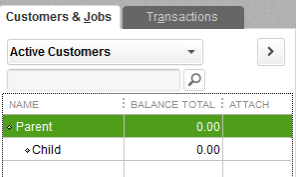2022
For Integration from Salesforce into QuickBooks
- If QuickBooks Customer and Salesforce Account object has hierarchy structures enabled, then the following changes have to be implemented within your DBSync mappings/template to facilitate hierarchy mappings.
- Let's say Avankia & DBSync are Parent & Child Account respectively in Salesforce. Also, Avankia & DBSync are the Customer & Job in QuickBooks respectively.
- The default mappings within DBSync standard template integrates the above Salesforce Account records as two separate Customer records "Avankia" and DBSync" - as opposed to Parent & Child records.
- Login to DBSync accounts with user credentials to make changes or create hierarchy mappings. Once the user has logged into his/her DBSync account, then click on the Development Studio to go to the DBSync Project page.
- Click on Projects page user will get a list of available projects and select the relevant project from the list.
- Users will get a list of available processes under the project section. Click on the relevant process to see a list of available workflows.
- Click on Create New Workflow and enter the workflow name AccountToCustomer2 and Save.
- After Creating the workflow 'AccountToCustomer2', move this next to the 'AccountToCustomer' workflow.
- Open the 'AccountToCustomer2' workflow to add Trigger and Rule properties from the 'AccountToCustomer' workflow.
- Once all the properties are filled, copy all the mappings from the 'AccountToCustomer' mapping page.
- Once the mappings are completed, add the following changes in the "Mapping page".
Target == "CustomerAddRq/CustomerAdd/ParentRef/FullName"
Source Field == "VALUE("Parent/Name")"
- Now use the following query in 'AccountToCustomer2' Trigger using Advanced Query Builder.
select {!.} from Account where AVSFQB__QuickBooks_Id__c = '' and Parent.Name!=''
- Similarly, replace 'AccountToCustomer' query with the query below:
select {!.} from Account where AVSFQB__QuickBooks_Id__c = '' and Parent.Name =''
- Once the user is done with all the above-mentioned changes, then "initiate the integration through web connector". Data will be integrated into QuickBooks with their respective hierarchies in place as shown below:
- This concludes Account hierarchy mappings for the data-flow from Salesforce into QuickBooks.
Overview
Content Tools
